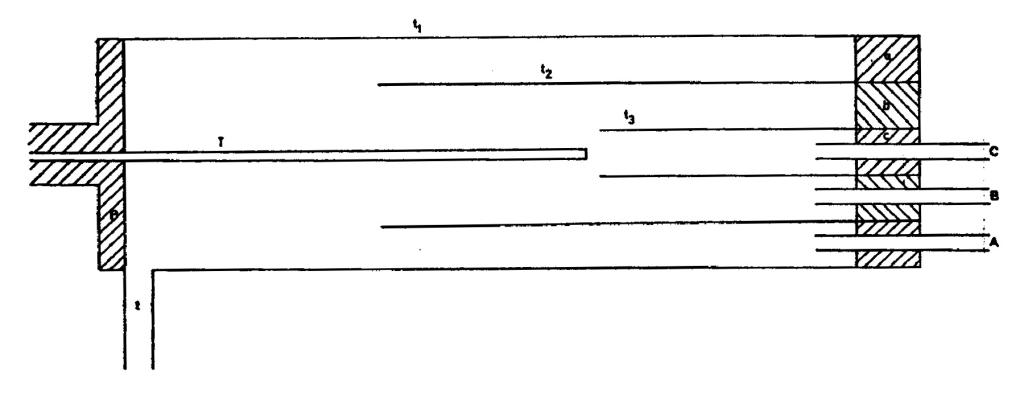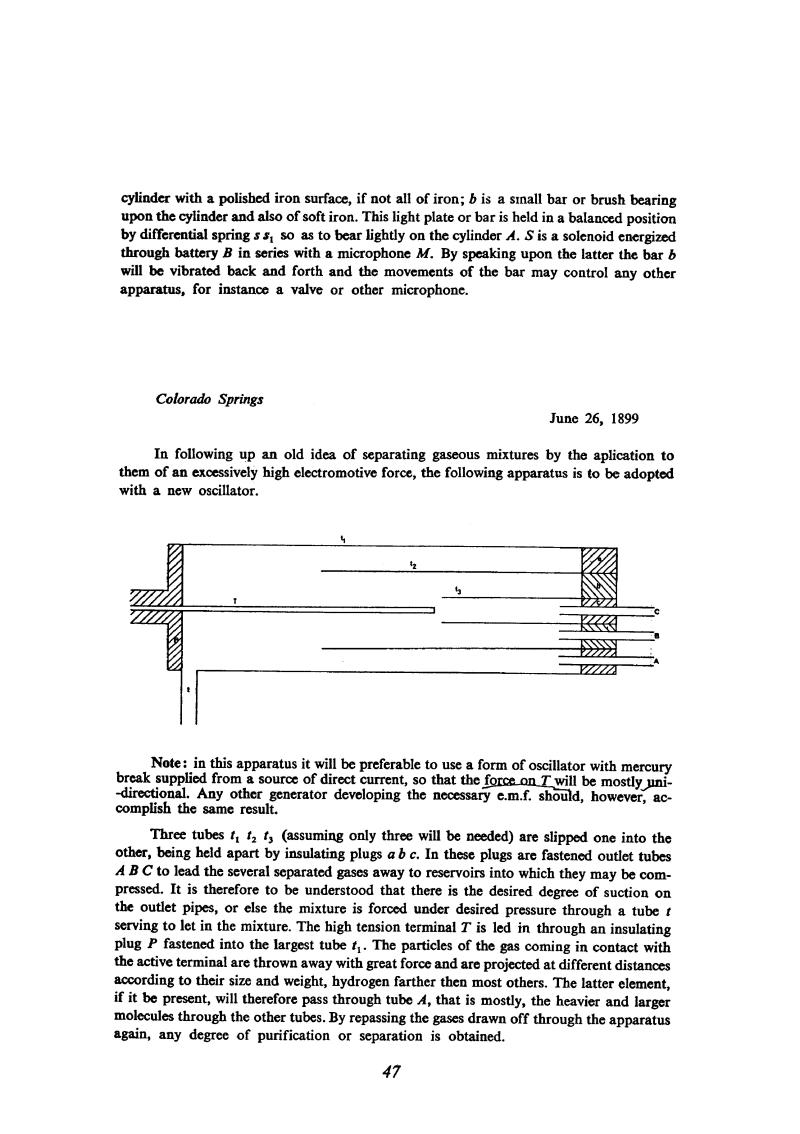
Nikola Tesla Books
cylinder with a polished iron surface, if not all of iron; b is a small bar or brush bearing upon the cylinder and also of soft iron. This light plate or bar is held in a balanced position by differential spring s s1 so as to bear lightly on the cylinder A. S is a solenoid energized through battery B in series with a microphone M. By speaking upon the latter the bar b will be vibrated back and forth and the movements of the bar may control any other apparatus, for instance a valve or other microphone.
Colorado Springs
June 26, 1899
In following up an old idea of separating gaseous mixtures by the application to them of an excessively high electromotive force, the following apparatus is to be adopted with a new oscillator.
Note: in this apparatus it will be preferable to use a form of oscillator with mercury break supplied from a source of direct current, so that the force on T will be mostly unidirectional. Any other generator developing the necessary e.m.f. should, however, accomplish the same result.
Three tubes t1 t2 t3 (assuming only three will be needed) are slipped one into the other, being held apart by insulating plugs a b c. In these plugs are fastened outlet tubes A B C to lead the several separated gases away to reservoirs into which they may be compressed. It is therefore to be understood that there is the desired degree of suction on the outlet pipes, or else the mixture is forced under desired pressure through a tube t serving to let in the mixture. The high tension terminal T is led in through an insulating plug P fastened into the largest tube t1. The particles of the gas coming in contact with the active terminal are thrown away with great force and are projected at different distances according to their size and weight, hydrogen farther then most others. The latter element, if it be present, will therefore pass through tube A, that is mostly, the heavier and larger molecules through the other tubes. By repassing the gases drawn off through the apparatus again, any degree of purification or separation is obtained.
47
June 25
The device shown in the drawing was intended to amplify the vibrations, in the following way: some of the power driving cylinder A is converted by friction of brush b against A into vibrations of b. Since the friction is a function of the current in the electromagnet, the vibrations of b have a time variation similar to the time variations of the current. If the circuit of the electromagnet includes a microphone and a battery, then the device should amplify the speech signal, brush b vibrating in synchronization with the speech pressure but with much more energy. This amplified signal could be used in a modulator (see June 13th and 14th). The drawing shown on p. 405 (from Tesla's slide in Nikola Tesla Museum, Belgrade) illustrates how Tesla thought of implementing some of these ideas*.
June 25
The device which is now shown on the drawing is intended for the vibrations amplification so that power portion required for the wheel 'A' rotating by means of electromagnet and track 'b' friction against wheel 'A' converts into track 'b' vibrations. Because the friction is dependent on current through electromagnet, longitudinal movements of track 'b' are proportional to current changes through the electromagnet.
Providing the microphone and battery are in the electromagnet circuit, the voice can be amplified by means of this device and track 'b' will vibrate in rhythm with the sound pressure, but with considerably higher intensity. So amplified vibrations can be used in a modulator assembly (please see June 13 and 14). According to drawing shown on page 17 (Tesla's slide from archives in Nikola Tesla Museum in Belgrade) it is seen how Tesla imagined that some of his ideas could be materialized.**
** So far it hasn't been established whether Tesla patented or he attempted to patent this modulator. It appears the the slide represents the copy of a drawing which was being prepared for patent submission.
June 26
The principle of this device using high voltages to separate gases would be that the molecules (in fact ions) of the different gases would behave differently because of their different mass: charge ratios. It is not known whether Tesla tried to verify this idea experimentally. In a later article(28) on electrical oscillators he mentions among the possible applications âformation of chemical compounds through fusion and combination; synthesis of gases; manufacture of ozone ...â but does not mention separation of gases, so that it may be he never went any further than the initial idea.
June 26
The device for gas mixtures separation by means of high voltage is based on molecular separation (actually ions) according to the ratio mass/loading. It is not known whether Tesla checked this idea experimentally. In one later article on electrical oscillator(28), amongst others he mentions as its application "obtaining the chemical combination through fusion and combination; gases synthesis; ozone production". Then he doesn't mention gases separation, and therefore it is possible that he didn't develop this idea further.
Described device consists of some elements of so called mass-spectrograph (device for isotope separation according to ratio mass/loading by means of combining action of electric and magnetic field) although, as Tesla described, it would probably not work as he expected.


